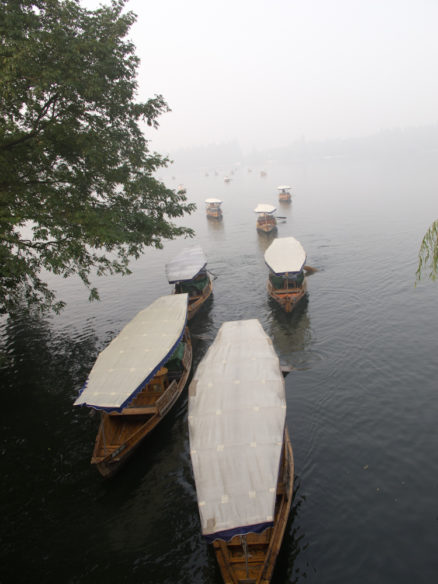
“Pleasure boats” glide on West Lake in Hangzhou, instead of loud motorboats.
SHANGHAI TO HANGZHOU
After spending six days in Shanghai, San Francisco’s Asian Art Museum delegation continued their fact-finding trip to Hangzhou (pronounced Hong-Joe), one of China’s most historic and—beautiful cities.
Hangzhou was the capital of the Southern Song Dynasty (1127-1279). Famed for its natural scenery, the city and its West Lake (Xī Hú) have been immortalized by countless poets and artists. Marco Polo is reported to have dubbed it “the most enchanting city in the world.”
Today it’s also the capital of Zhejiang province and home to 6 million people. With its hi-tech companies such as e-commerce Alibaba.com, it is often compared to California’s Silicon Valley.
THE BULLET TRAIN
I followed the group to Hangzhou. Although I have travelled there before, this was my first time taking the new, sleek bullet train that went into service on October 28, 2010. At a top speed of 261 miles per hour, the train made the 120-mile trip in just 45 minutes.
One of the few times I become aware that I’m in a country with a population of over a billion people is when I’m at a train station. The number of travelers is overwhelming, and I’ve learned never to travel during the major Chinese holidays, when the crowds (as during our Thanksgiving and Christmas holidays) are even larger than normal.

The Asian Art Museum delegation from San Francisco rode the new 45-minute bullet train to Hangzhou. The high-speed train leaves from the suburban Hongqiao railroad terminal next door to the domestic Hongqiao airport.
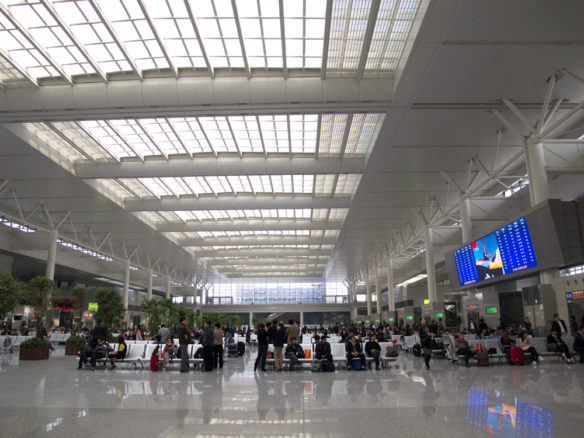
The Hongqiao train terminal is gigantic, with a waiting room the size of a football field. Everything is new and clean, with windows and skylights that let in natural light, tons of marble, and row after row of benches.
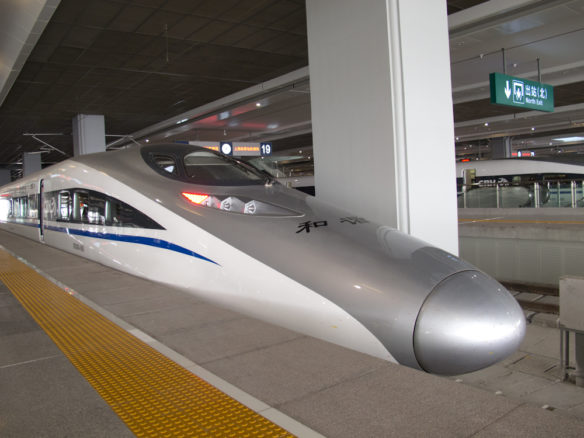
With a top speed of 261 miles, the bullet train cuts the 120-mile trip between Shanghai and Hangzhou from three hours (in a car, with traffic) to just 45 minutes.
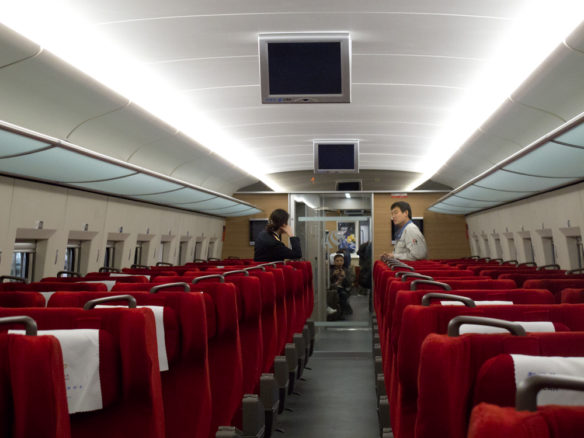
Even for the high-speed train, the fare is as low as $12 and just $20 for first-class . (I travel first-class because the crowds can be overwhelming). The first-class car appeared to be virtually the same as the other cars, though the red seats seemed a bit plusher.
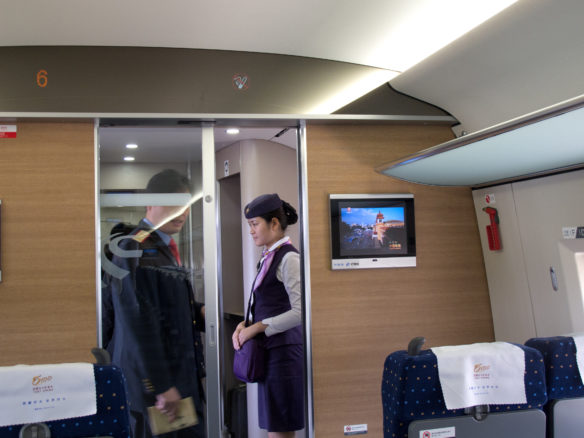
I like the fact that the train staff greets you as you board. They dress professionally in crisp uniforms, and the women pull their hair into buns tied with bows.
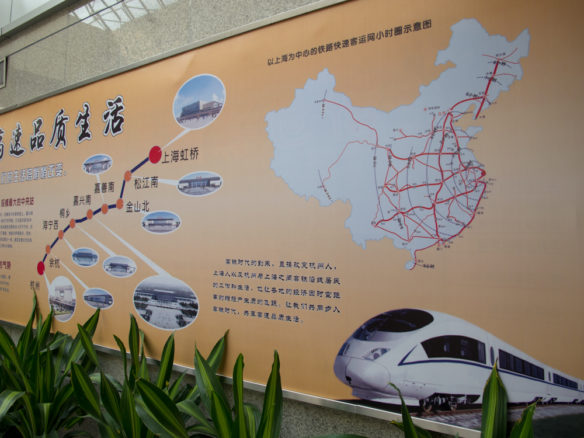
It’s estimated that China is investing $300 billion to expand its high-speed rail network to over 9,941 miles by 2020. Opening soon is the high-speed rail from Beijing to Shanghai (costing $34 billion) that will cut the 818-mile journey from 10 hours to 5 hours.
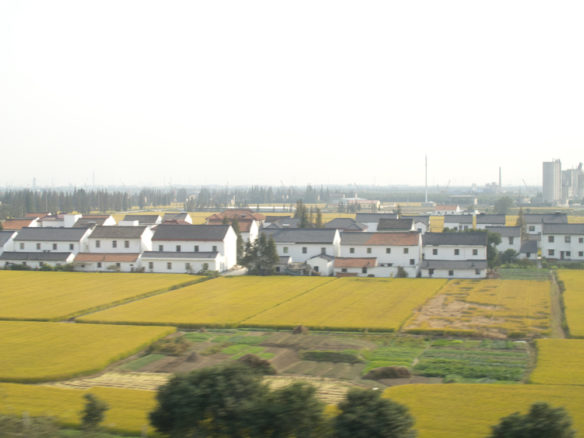
In Land Use and Abuse in America: A Call to Action, Peter M. Wolf observes “China’s soon-to-be 8,000 miles of true high-speed rail compares to a projected 84 miles (to link Tampa to Orlando) set to come online in Florida in 2014.” I wonder what we are waiting for?
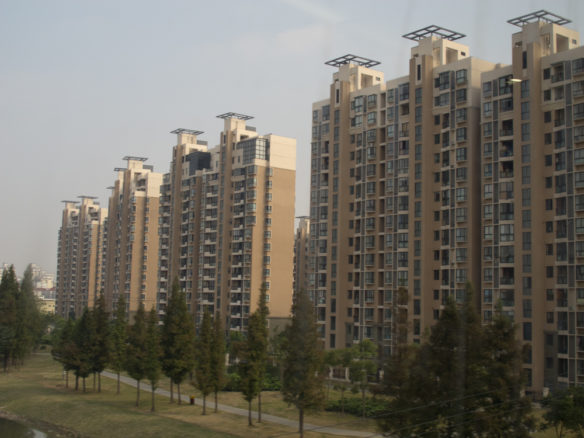
The train was quiet and fast, zipping past farms and villas. Closer to the city I noticed a change in scenery with newly developed suburban subdivisions and high-rise apartments.
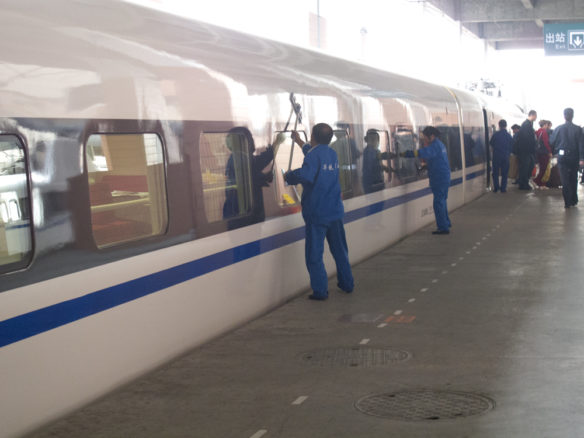
I was impressed that as soon as we arrived, a team of maintenance workers swiftly cleaned the train inside and out, keeping it immaculate.

I thought I knew the ropes, so I didn’t arrange for a driver. Big mistake. Outside the station was mass confusion: honking traffic, bicycle carts, people hawking rides, masses of pedestrians, no sidewalks, no marked crosswalks, and no taxis.
FOUR SEASONS HOTEL HANGZHOU AT WEST LAKE
After arriving in Hangzhou, I grabbed a taxi to the gated enclave of the Four Seasons Hangzhou that opened in October 2010. Situated along an inlet on the western side of West Lake, it offers 17 magical acres of landscaped gardens with footpaths and a series of lagoons, streams and lily ponds.
It is touted as “combining centuries of tradition with chic contemporary style” [by whom?] and has become the place to stay in Hangzhou. Nothing is perfect, but Hangzhou’s newest hotel comes very close.
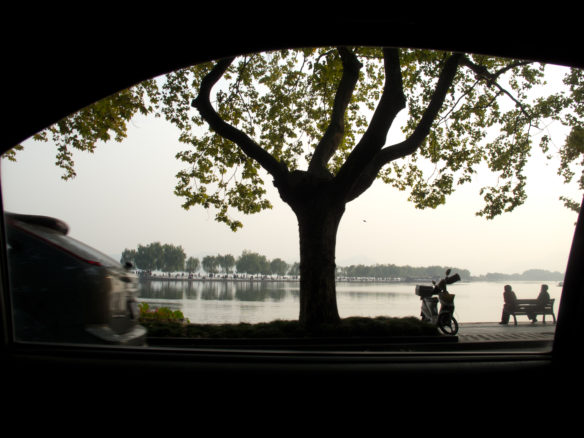
As I rode to the Four Seasons hotel, I enjoyed glimpses of the famed West Lake and passed grand old houses.

The Four Seasons hotel is constructed in regional Jian Nan architectural style, with white walls, black roofs, and traditional features such as pagoda-style peaked roof pavilions and upturned eaves.

The doorman greeted me and whisked my bag out of the taxi and into a spacious lobby with a bubbling fountain. In fluent English, the staff said, “We’ve been waiting for you.” That’s what I call hospitality—I felt so welcomed.
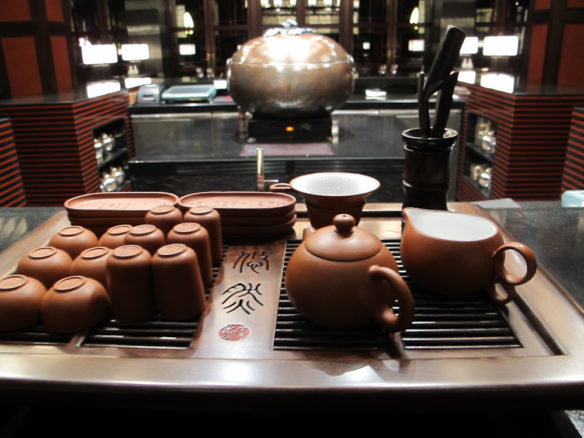
During check-in, I sat in the lobby sipping Longjing green tea, a local specialty, and enjoying the sounds of Asian music and the dancing water fountain—a very serene experience, especially after my trip.
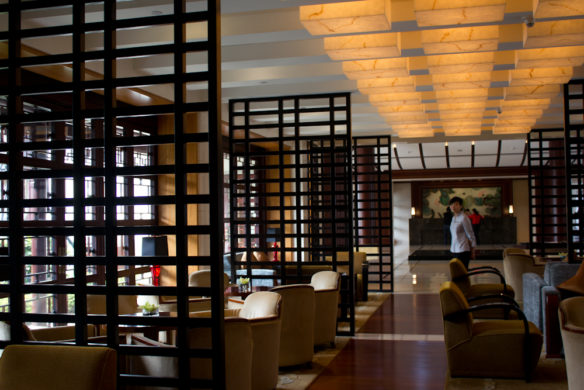
The décor is very soothing. Unlike so many of the modern, “international-style” hotels that have cropped up in China, the Four Seasons blends so beautifully with the landscape that it seems as if it has always been there.
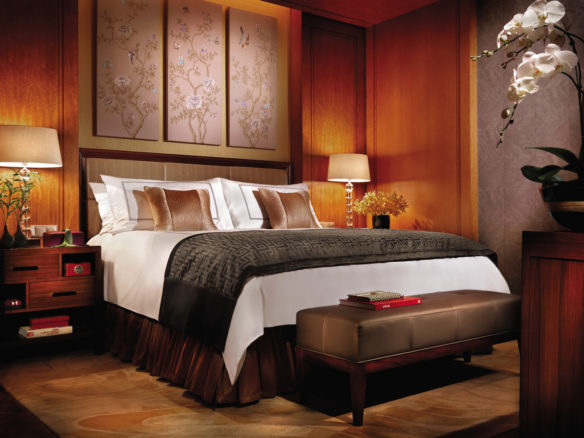
My guest room was spacious and serene, with a desk and sitting area.
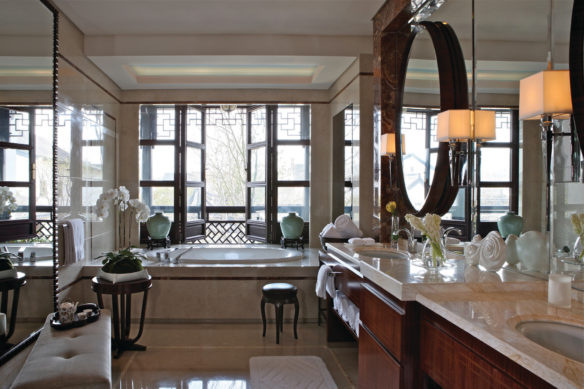
The large bathroom, with an oversized tub, overlooked a garden. Everything was of the highest quality, and I was ready to move into the hotel for life.

The spa, with multi-room treatment areas, offers a wide range of services. I was escorted to one of the biggest spa rooms I’ve ever seen, with two massage tables sprinkled with flowers and a gigantic soaking tub of gold-colored tiles.

My favorite room feature was the veranda that overlooked a garden. Its latticed windows opened to let in a fresh breeze. I could hear the water features, the birds singing, and music from a nearby park. Heaven!
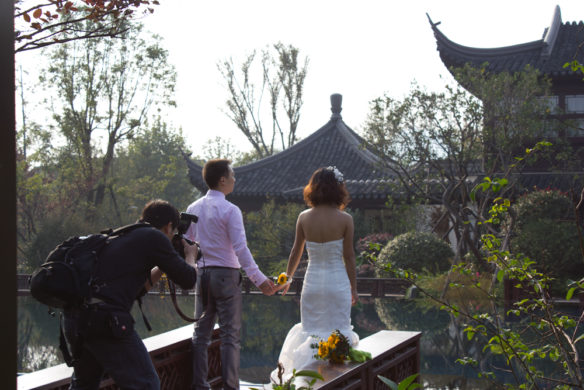
A romantic wedding in the garden.

A custom getaway car for the newly married couple.
A WEST LAKE WALK
After unpacking, Eliza Cash, Gina Chu and I headed out for a walk around West Lake for some exercise, fresh air, and to take in the beauty of the lake that is a must-see when visiting Hangzhou.
West Lake is in the heart of Hangzhou. The partially man-made lake is more than 1000 years old, has an area of 2.2 square miles and is ringed by undulating hills on three sides.
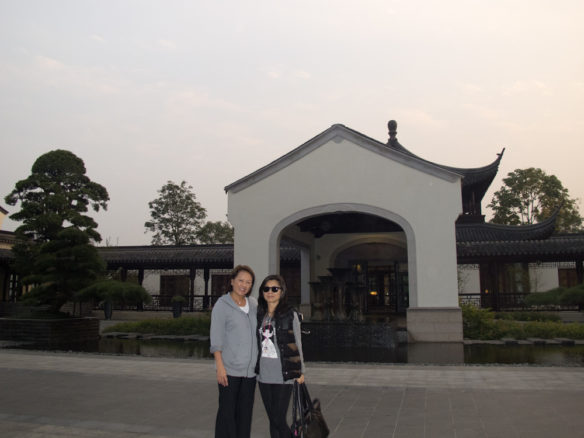
Eliza Cash, Gina Chu and I explored more of West Lake on foot and enjoyed the aesthetics of a traditional Chinese garden with temples, pagodas and scenic views. “This is a jewel,” Eliza said.

Famed for their natural scenery, Hangzhou and its West Lake (Xī Hú) have been immortalized by countless poets and artists. There are plenty of secluded spots for meditation and contemplation.

West Lake is a playground where people ride boats and bicycles, paint, practice tai qi, play cards, sing, and enjoy nature and tranquility.

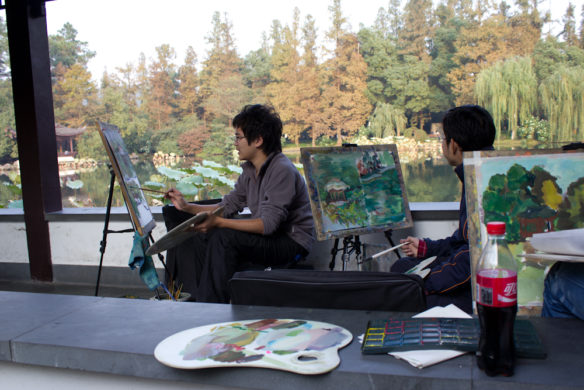


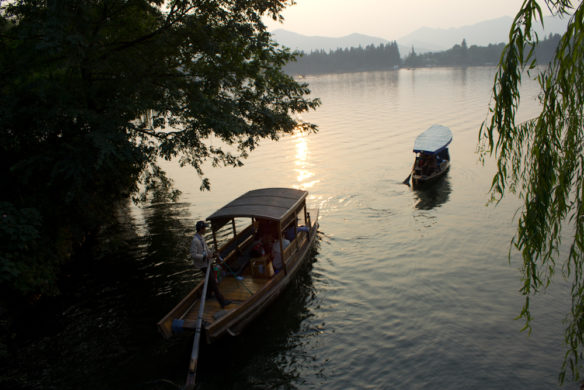
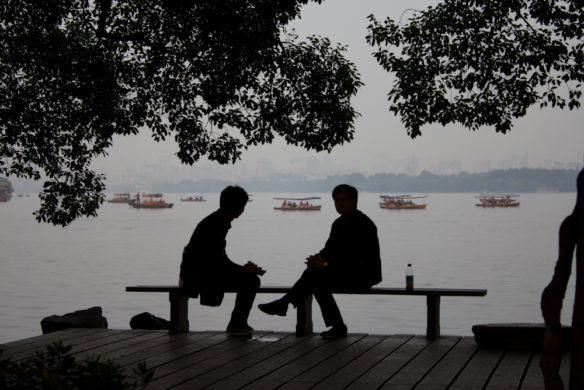
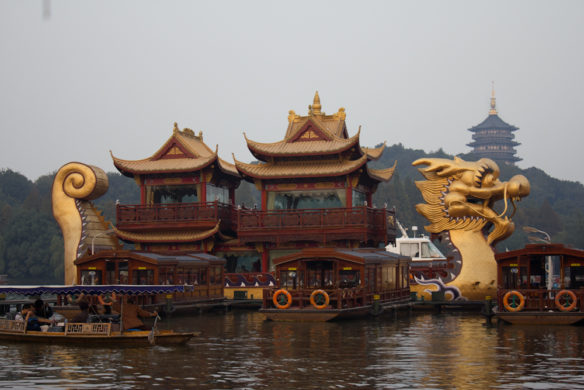
Visitors cruise the enchanting lake in a dragon boat. One can see why West Lake inspired so many beautiful legends and stories. The occasional pagoda and Chinese-style arched bridge add to the atmosphere of the tree-lined walkways, four verdant islands and surrounding hills.
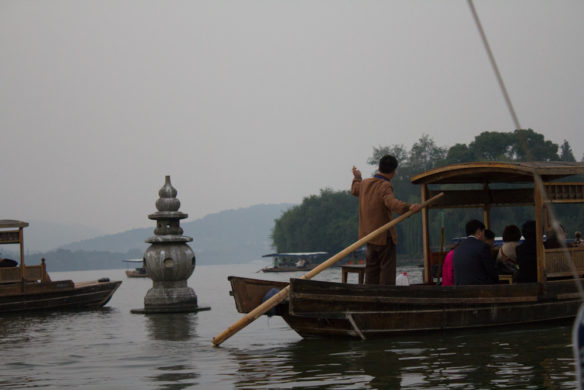
We floated past three miniature stone pagodas that were built over 800 years ago. They act like beacons and are the centerpieces of the scenic spot called “Three Pools Mirroring the Moon.”
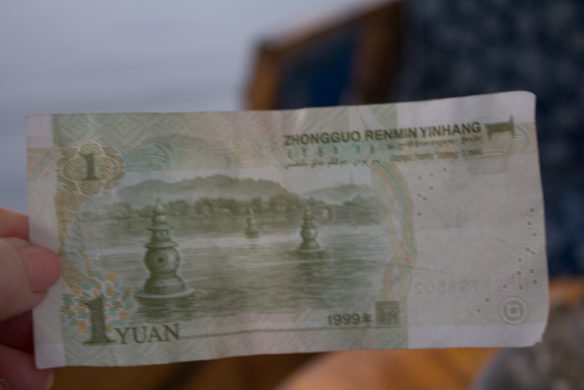
My rower pointed out that the stone pagodas are illustrated on the back of China’s one-Yuan note, which is like our $1 bill.
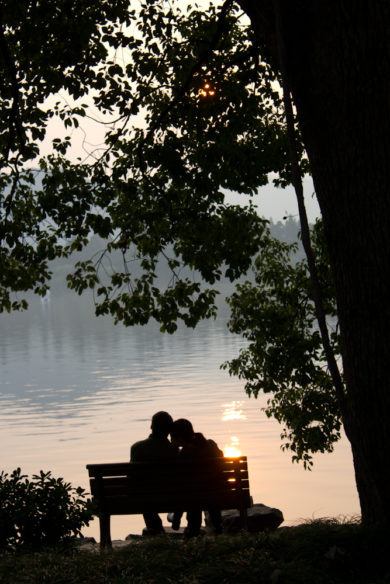
A romantic spot on West Lake.
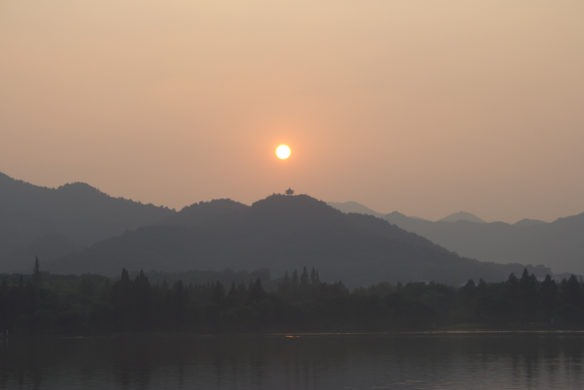
Watching the sunset.
VISITING MUSEUMS AND STUDIOS
This day was filled with art-related activities. Asian Art Museum director Jay Xu was on hand to give in-depth commentary. It is such a treat to travel with him, as he knows everyone and has the knowledge to explain what we are seeing.
He made a point of saying the focus of the trip was to view contemporary art; it wasn’t about shopping or sightseeing.
SHI HUI STUDIO
The first art stop was the studio of Shi Hui, a pioneer fiber artist who creates works of paper in many forms. She is constantly experimenting with fibers and uses conventional and hi-tech methods. Her work “Floating” (2007) is at the National Arts Museum in Beijing.
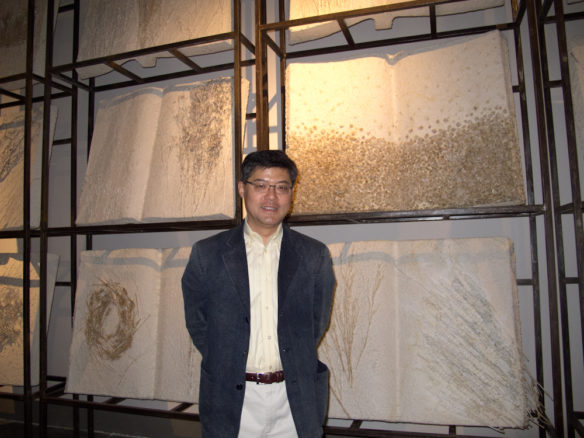
AAM director Jay Xu explained that Shi Hui is a contemporary artist inspired by traditional designs. She works with cotton, hemp, rice paper, paper pulp and fiber optics.
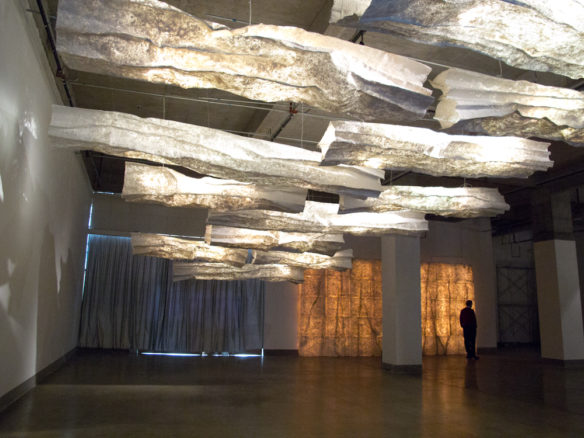
Artist Shi Hui was born in Shanghai, graduated from the China Academy of Art and currently teaches there. She is married to the academy director, artist Xu Jiang.
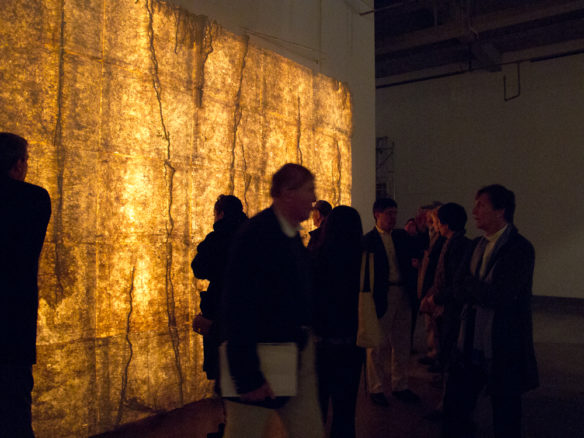
Shi Hui uses lights behind the pulp to show its texture. The works have the feeling of Chinese ink paintings.
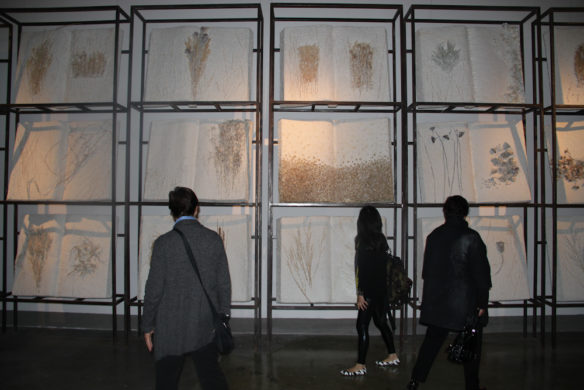
With her creative use of fiber material, Shi Hui’s work visually recreates a Ming encyclopedia of Chinese herbs.
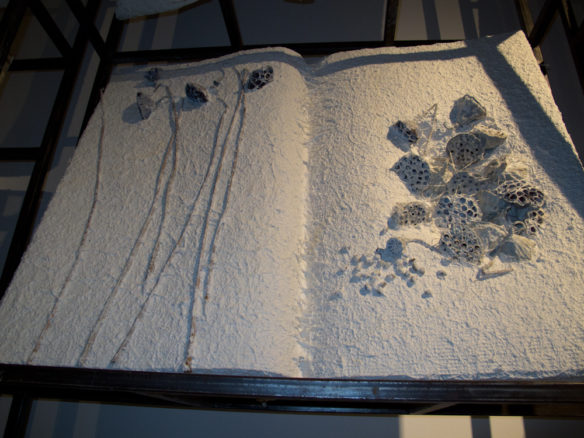

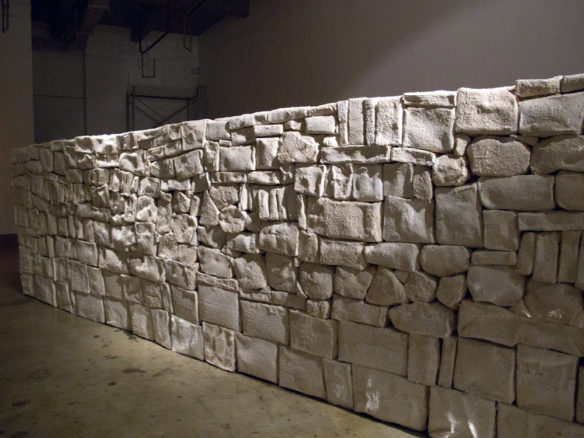
We admired a textured wall, built in sections, all made of fiber.
ZHEJIANG MUSEUM
The next stop was the Zhejiang Museum of Art on Nanshan Road, adjacent to West Lake. It opened officially in August 2009, and most of us had not yet discovered this gem.
It is the largest modern art museum in China today—at least until a new one under discussion in Beijing is actually built.
Director Ma Fenghui greeted us; I noticed the camaraderie they had with Jay. A scholar of Chinese antiquities, Jay is a two-way emissary who is able to move easily between the U.S. and Asia.

Our group spent the morning at the Zhejiang Museum, currently China’s biggest modern art museum. The large exhibition was artist Xu Jiang’s A Tribute to the Garden of Sunflowers.
XU JIANG’S “SUNFLOWERS”
The highlight was Xu Jiang’s exhibition, A Tribute to the Garden of Sunflowers, as he believes the golden flowers, cultivated for their edible seeds, are the perfect symbol of China.
Xu Jiang is also director of his alma mater, China Academy of Art (Hangzhou), a founder of the Shanghai Biennale and the author of several art books. Art Review named him one of art’s “Power 100.”
To the generation of artists who grew up during the Cultural Revolution from 1967-1977, the sunflower has historical and political implications that Westerners may not be aware of.
They were taught to follow the sun (meaning Chairman Mao and Chinese leaders), just as the sunflower always follows the sun.

We were greeted by a forest of withered bronze sunflowers and lotus plants reaching to the sky. The eye-catching golden sunflower stalks, made up of 720 fiberglass pieces and cast in steel, made a powerful impression.
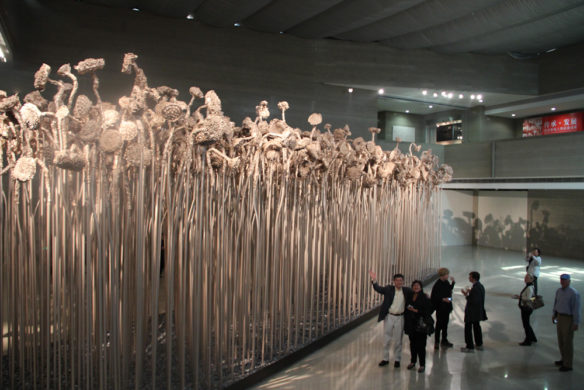
One member of our group asked why Xu Jiang used withered sunflowers rather than colorful ones like Van Gogh did. He explained that the Cultural Revolution was a melancholy period, so muted colors fit the times.

“Mine lament the pain and burden, especially carried by the Chinese nation. Many were moved to tears from the collective suffering of a generation for whom paradise was lost,” he said.
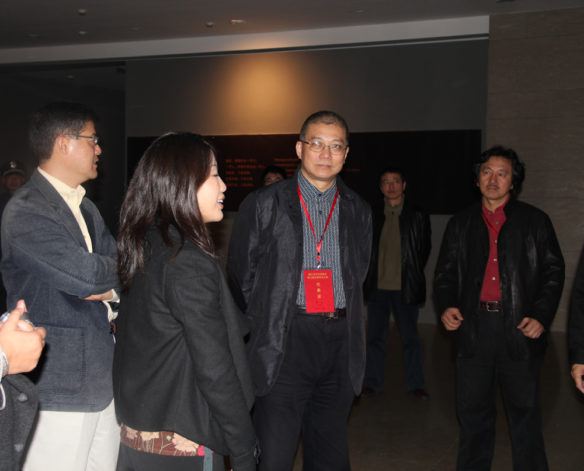
Artist Xu Jiang, center, and Ma Fenghui, director of Zhejiang on right. The show was a blockbuster in China and very well attended, especially by members of the artist’s generation.

Our Abercrombie & Kent guide, Bill Hurst, said we were the first group that he has taken to this museum, but I am sure that when others—especially the art crowd—hear about it, it will be on everyone’s agenda.
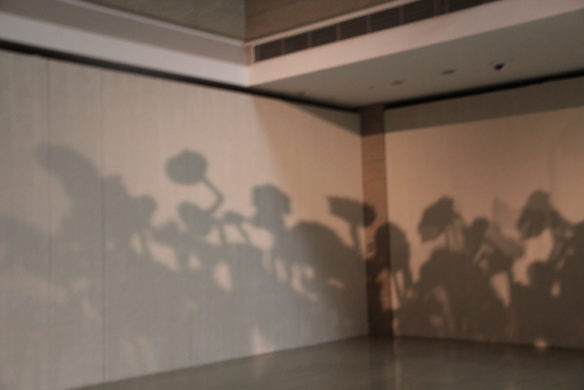
The sculpture cast a wonderful shadow. “Wow!” exclaimed Jay Xu—he immediately began planning. “This would be wonderful on the Civic Center Plaza in front of the Asian Art Museum.”
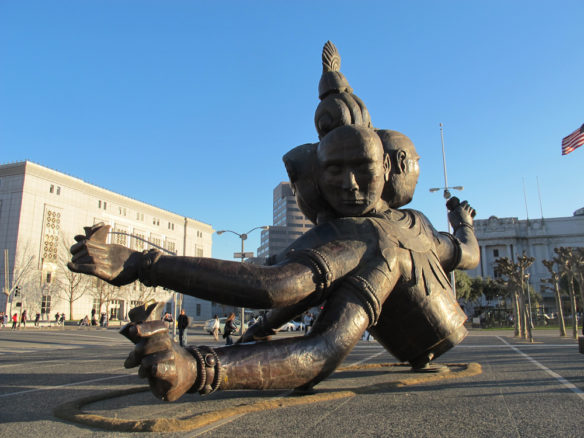
Imagine 1,000 withered bronze sunflowers in a row where Zhang Huan’s Buddha sculpture Three Heads Six Arms stood this year.
LUNCH AT JIANG NAN HUI CLUB
Lunch was at Jiang Nan Hui, a private club whose founders include Alibaba CEO Jack Ma (China’s Bill Gates). “This is where deals are made,” we were told. It certainly looked that way at the entrance, where a line of elite cars, including three Rolls Royces and their chauffeur/bodyguards, waited.
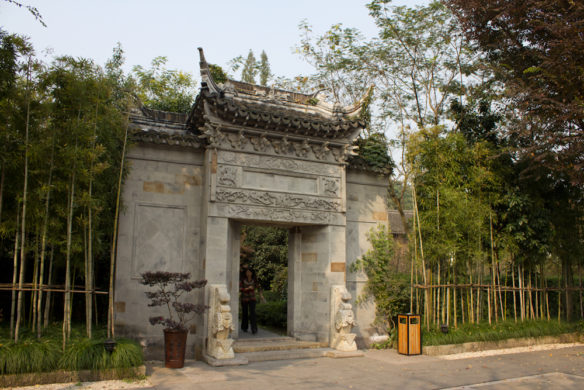
Through the Museum’s connections, we lunched at an exclusive and private club, Jiang Nan Hui, which we were eager to see.

Maria Kahng and Stephen Kahng.
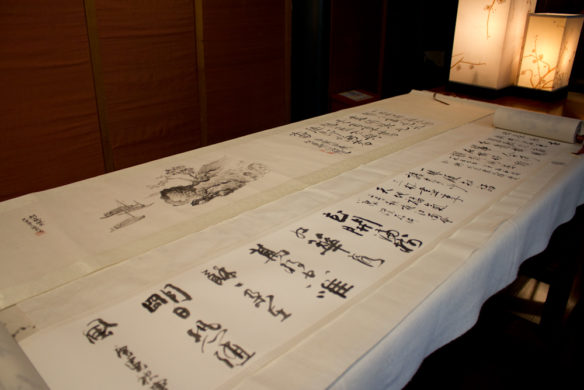
In the club’s library is a collection of traditional scrolls and literature to read and study.

The club has many special touches, including a guestbook to be signed and a tearoom with all the utensils to host an elaborate tea ceremony.
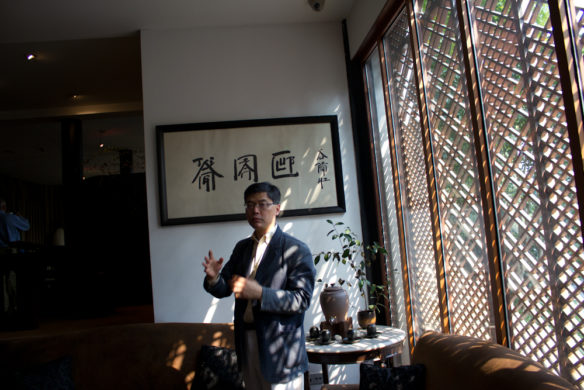
A wall plaque by artist Xu Bing that looks like Chinese, but reads like English; it spells out the name of the club in English. If you look closely, you will see it.
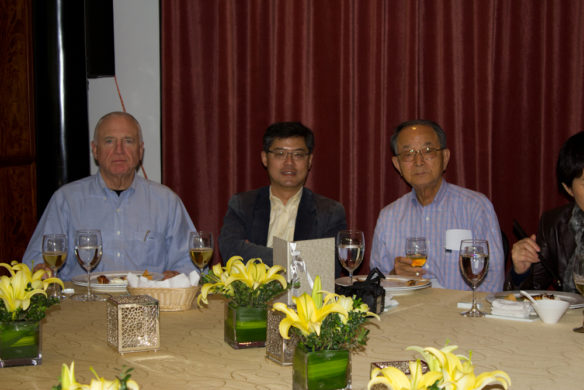
Jack Wadsworth, AAM director Jay Xu, and Chong-Moon Lee.
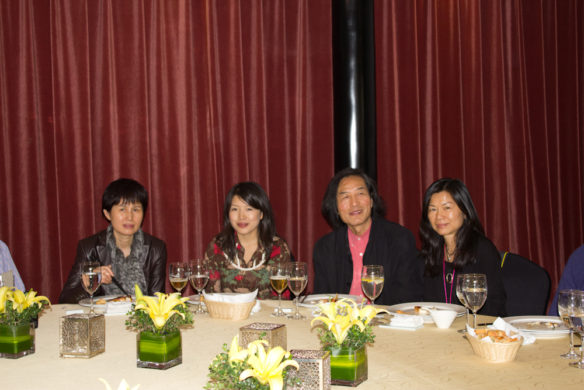
Artist Shi Hui, interpreter Stella Wang, calligrapher Wang Dongling, and Gina Chu.

Dick Kramlich, Dipti Mathur, Susy Wadsworth, and Pam Kramlich.
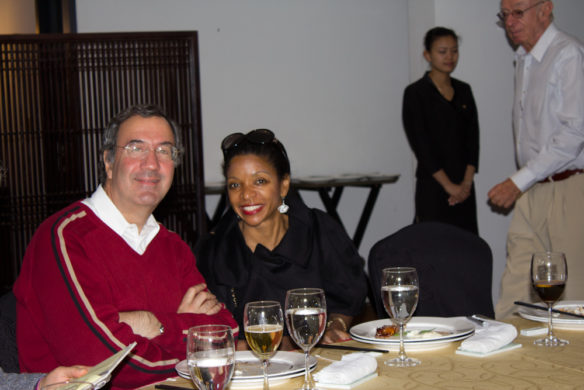
Pamela Joyner and husband Alfred Giuffrida.
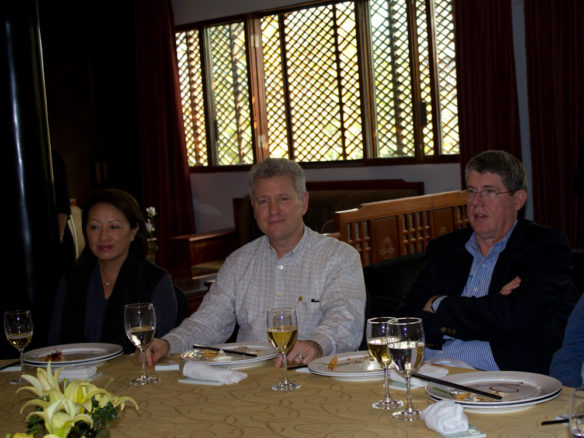
Eliza Cash, Dean Cash, and Fred Gordon.
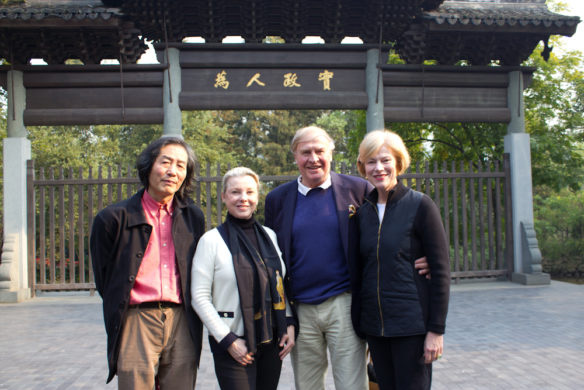
Artist Wang Dongling, Jeanne Lawrence, Dick Kramlich, and Pam Kramlich.

Private rooms where the head honchos can avoid the limelight and have discreet meetings.
CHINA ACADEMY OF ART HANGZHOU
After lunch we visited one of the oldest and most prestigious art schools in the country, the China Academy of Art (formerly the Hangzhou Academy of Art). The Academy has been one of China’s leading schools for the past thirty years and is considered more conservative than the Beijing National Academy.
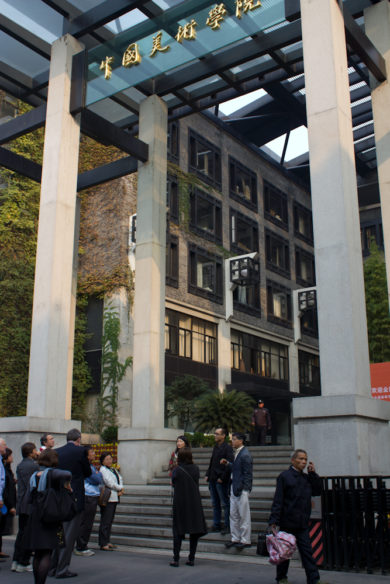
Director and artist Xu Jiang met us at the China Academy of Art, Hangzhou.
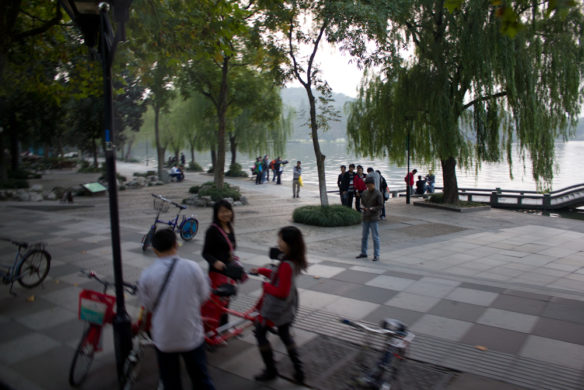
Directly across the street is the famed West Lake, a wonderful place for the students to enjoy.
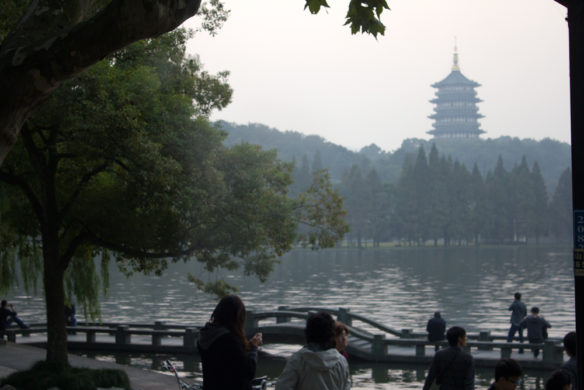
The view of West Lake and Leifeng Pagoda.

Interpreter Stella Wang, Gao Shiqiang, and AAM director Jay Xu.
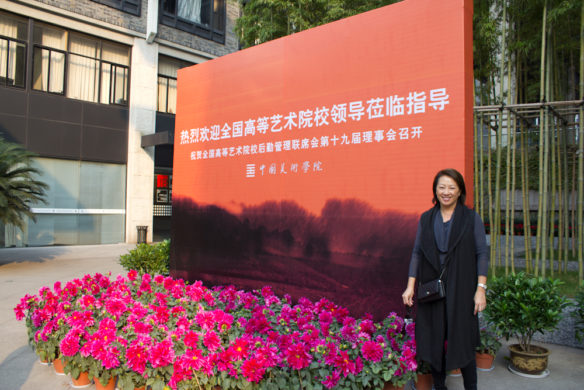
Eliza Cash admired the flowers in front of the China Academy of Art.
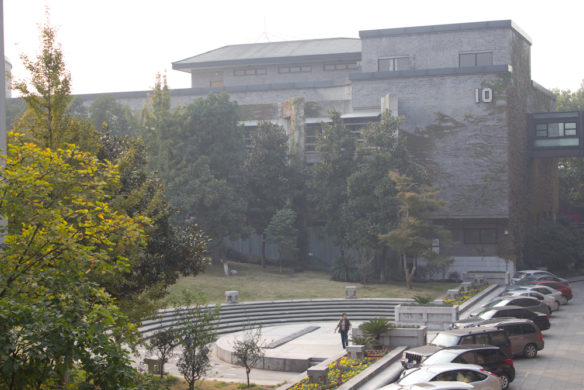
The Academy is made up of a series of modern buildings.
Calligraphy Professor Wang Dongling
We met Wang Dongling, dean of the calligraphy department. Regarded by the Chinese as the highest expression of all art forms, calligraphy has been flourishing and evolving in China for over 3,000 years.
Wang Dongling has made ancient calligraphy modern and bold and turned it into performance art.
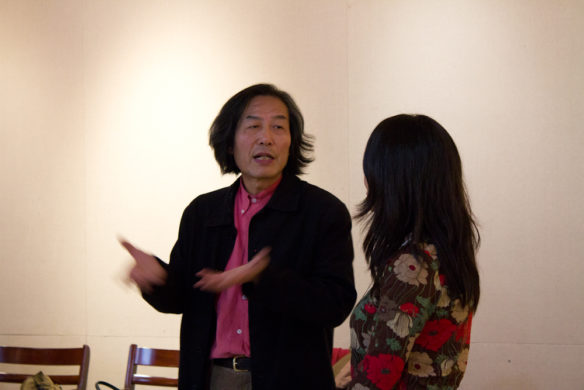
Academy professor Wang Dongling is a master of the ancient art of calligraphy.

When we arrived for Wang Dongling’s performance, we were joined by a group of students from the U.S. attending a two-week calligraphy course at the academy. The ones with hands up are from California, too.
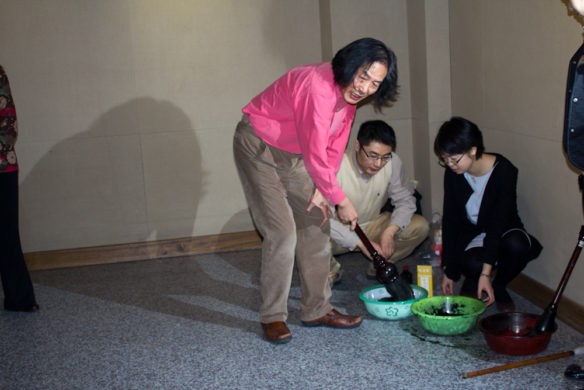
After his assistants ground an ink stick in water, Wang Dongling lifted a brush about half his height, the biggest brush I’d ever seen.

“You have to be in good health in order to handle this large ink brush and make strokes, a very physical act,” he joked, as he picked up a brush that looked as if three people would be needed to hold it.

We watched silently and intently as the professor wielded a brush that took strength just to hold, dipped it into the jet-black ink, and made the strokes on paper that demonstrated his skill.

The professor takes the art of ancient calligraphy and makes it modern and bold in order to increase interest in Chinese culture.
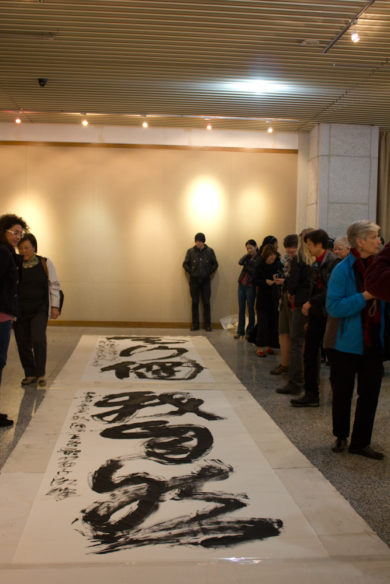
We were fascinated watching the artists in action creating the strokes with the brush—it was performance art.

The extraordinary variety of calligraphic techniques, styles and compositions that have been created by Chinese artists is without parallel in the world.

Jay Xu studies Wang Dongling’s calligraphy on the wall of the student café (I hope it will be protected).

Artist Shi Hui and Wang Dongling, Jay Xu, and Professor Guan Huaibin.
BANQUET DINNER AT HU XUEYAN HOUSE
On the delegation’s last night in Hangzhou, a banquet feast was held at the villa of Hu Xueyan, built in 1872 by the richest man in Hangzhou. It is located near Hefang Street, which is famous for its well-preserved Ming and Qing dynasty buildings. Recently the Hangzhou government took over the complex and beautifully restored it.
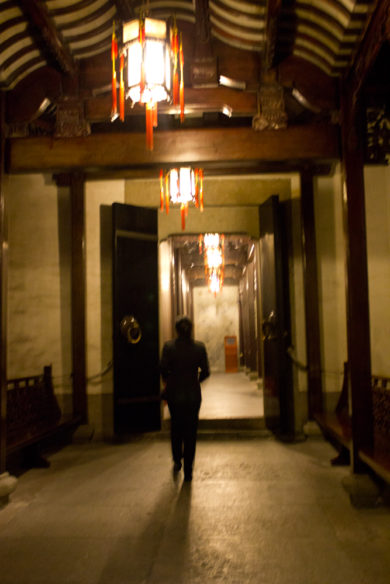
On their last night in Hangzhou, the group celebrated at dinner in the magnificent Hu Xueyan Villa. It was a perfect send-off, as the next morning they flew to Beijing.
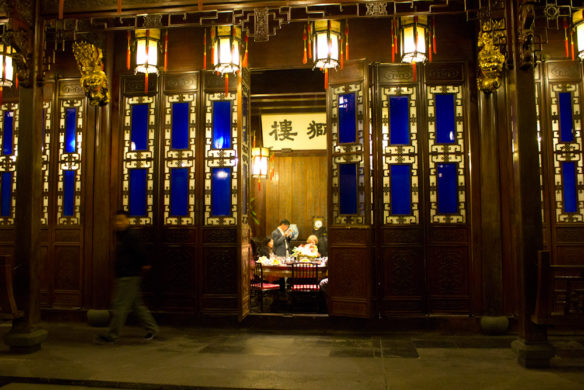
The wealthiest man in town built the villa in the 1800s; the compound consists of traditional buildings surrounding an enormous courtyard.
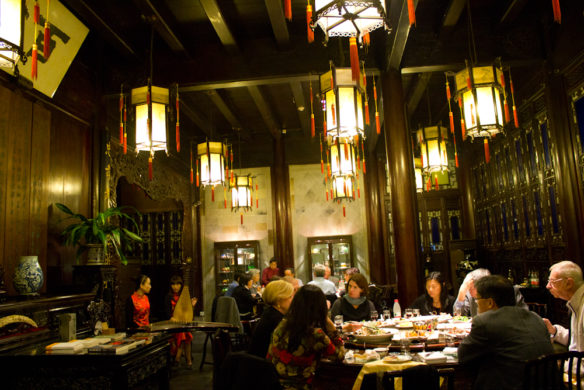
The tall-ceilinged private hall, with its original dark-wood paneling, has been turned into a banquet hall where we were served a feast.
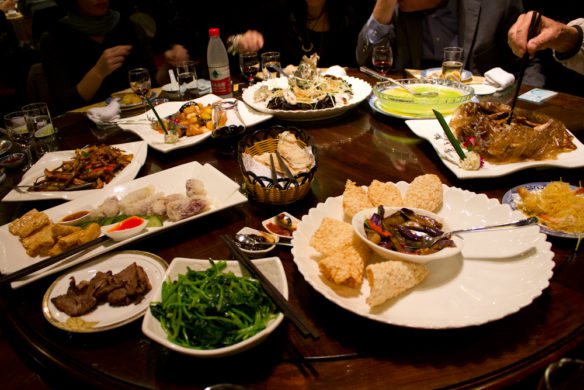
Everything from the beggar’s chicken to the sautéed fresh greens was delicious.

Beggar’s chicken is wrapped in lotus leaves, parchment paper, and thick mud before it’s cooked. This unique cooking technique produces the most juicy and delectable chicken.

Yin and Yang Soup.
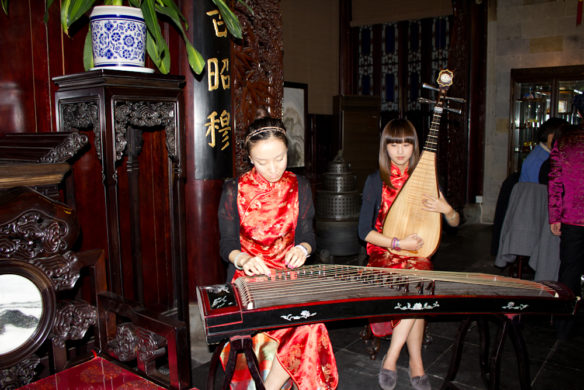
Entertainment using ancient Chinese strings instruments.
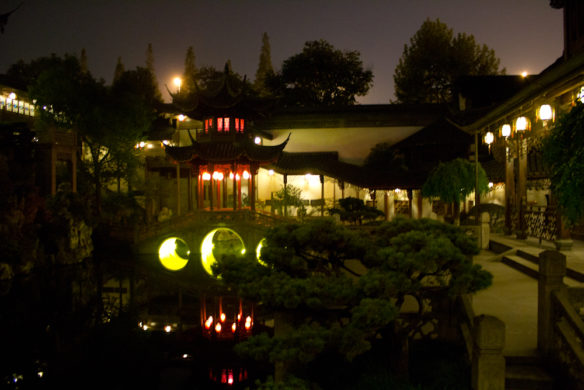
The villa complex, covering a couple of acres, includes 13 towers, pavilions, terraces, a small bridge over a flowing stream, verandas, and the magnificent Zhiyuan Garden, plus rooms for family, servants, and guests.
BICYLE RIDE AROUND WEST LAKE
The group left on an early morning flight for Beijing for more jam-packed days. I remained to enjoy a few more days in Hangzhou, a city where I had always wanted to spend extra time. It’s a great place to recover from a super-charged China itinerary.
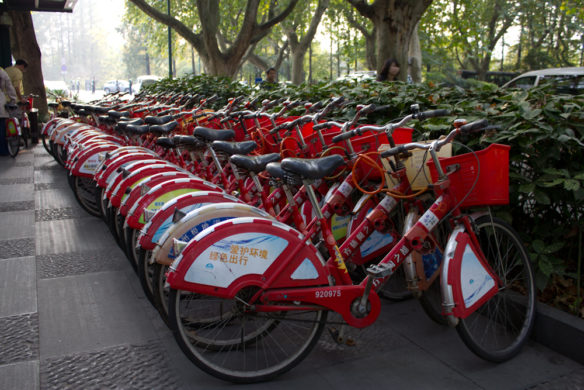
Early morning the next day, I rented a bicycle so I could cover more territory.

Visitors were already lined up to visit the temple.

Colorful sundry shops dot the walkways, and a few even serve corn-on-the-cob.
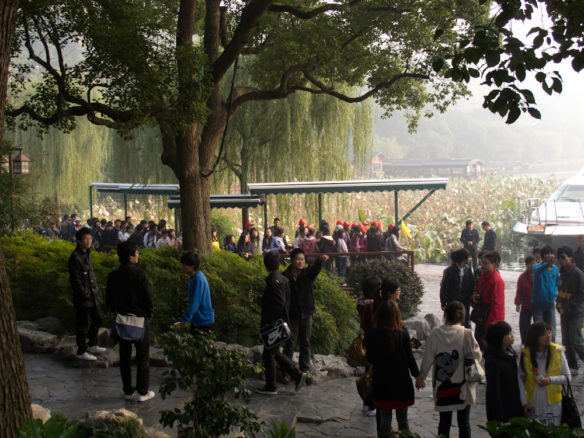
This is modern Hangzhou, a top tourist destination where there are crowds everywhere.
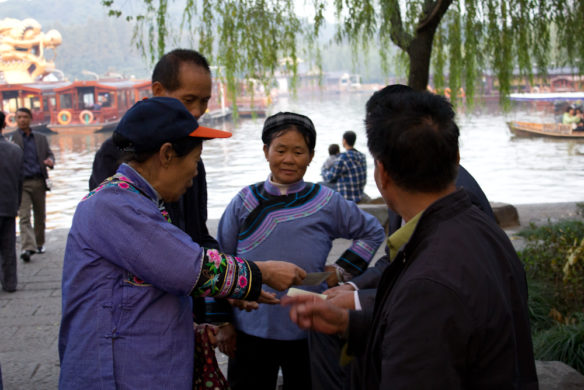
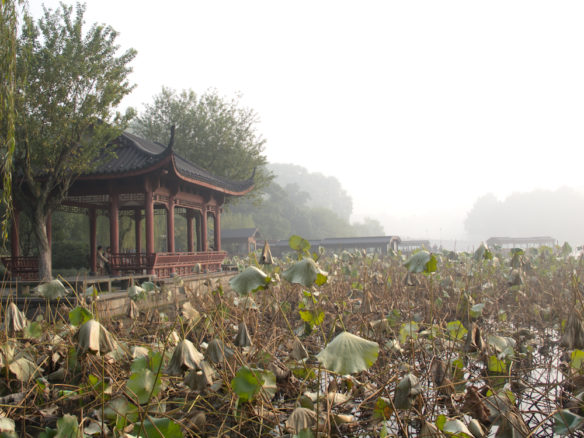
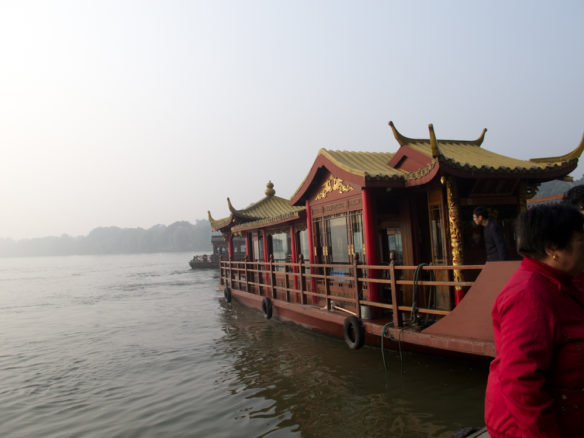

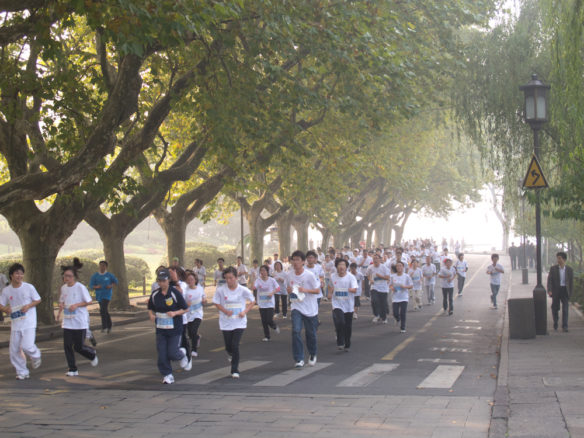
As I walked peacefully around West Lake, I was amused to see that zooming out of nowhere came runners in a 7-kilometer race.
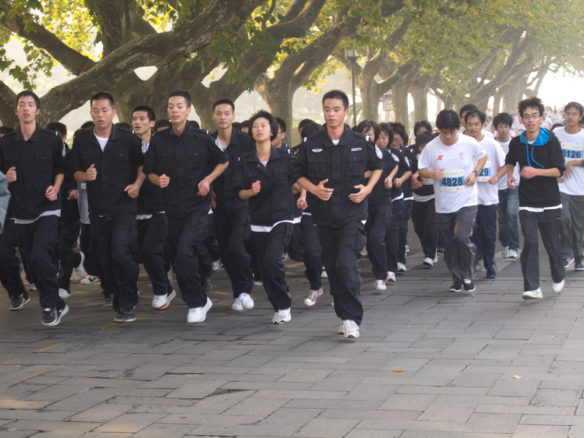

They ran past Yue-Fei’s Temple, built in 1221 during the Song Dynasty to commemorate General Yue Fei.
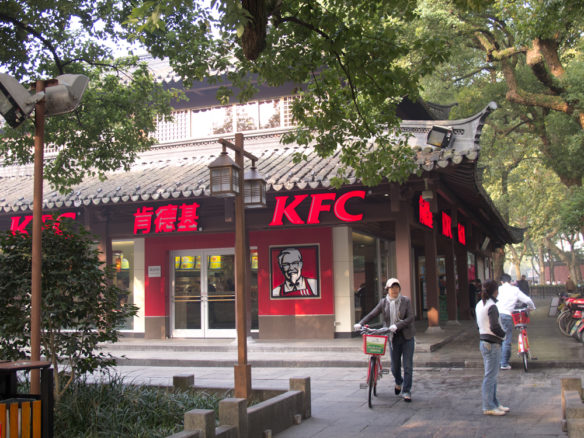
On the flip side are the modern KFCs popping up everywhere, even in this spot of natural beauty.
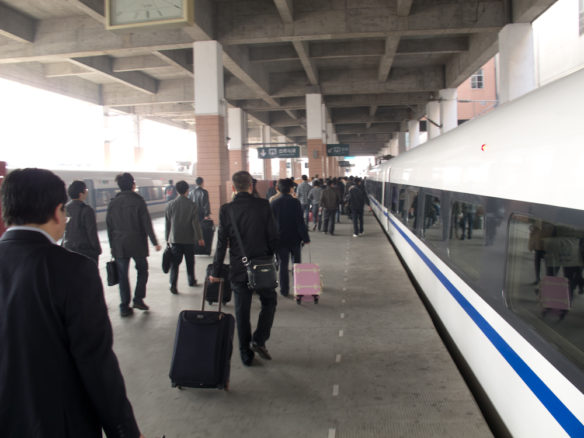
Catching the train at the Hangzhou train station to return to Shanghai.
Photographs by Jeanne Lawrence
*Urbanite Jeanne Lawrence reports on lifestyle and travel from her homes in San Francisco, Shanghai, and New York, and wherever else she finds a good story.
